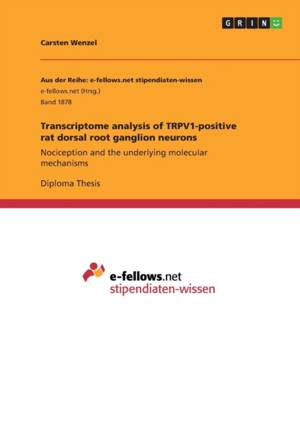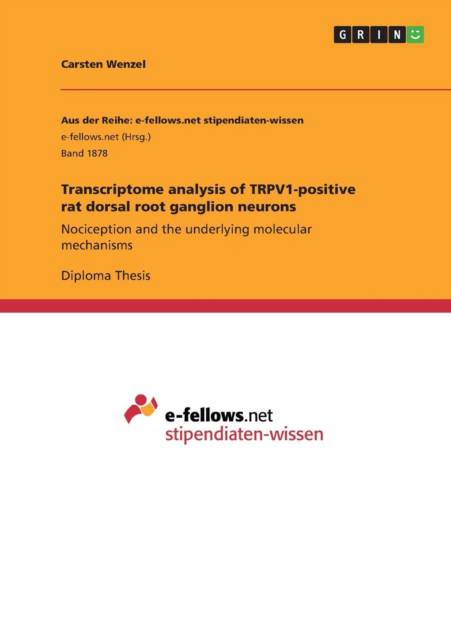
- Afhalen na 1 uur in een winkel met voorraad
- Gratis thuislevering in België vanaf € 30
- Ruim aanbod met 7 miljoen producten
- Afhalen na 1 uur in een winkel met voorraad
- Gratis thuislevering in België vanaf € 30
- Ruim aanbod met 7 miljoen producten
Zoeken
Transcriptome analysis of TRPV1-positive rat dorsal root ganglion neurons
Nociception and the underlying molecular mechanisms
Carsten Wenzel
€ 120,95
+ 241 punten
Omschrijving
Diploma Thesis from the year 2011 in the subject Medicine - Biomedical Engineering, grade: 1,0, Technical University of Berlin (Biotechnologie), language: English, abstract: Pain is an unpleasant sensory and emotional experience and an essential component of the body's defense system. Noxious stimuli are detected by special afferent sensory neurons called nociceptors (or nociceptive neurons), which connect peripheral tissues with the central nervous system. Noxious signals travel along the nociceptor to the dorsal horn of the spinal cord from where they projected to higher brain regions via 2nd order neurons. After evaluation in brain stem, thalamus, and cortex a complex sensory perception arises: Pain. Extensive research has been performed to gain insight into molecular mechanisms of pain sensation and its modulation. Many of the transduction channels that convert thermal, mechanical or chemical stimuli into electrical activity are transient receptor potential (TRP) ion channels, which are widely expressed in nociceptors and play a prominent role in pain sensation. Still many transduction molecules that trigger pain have not been discovered. To identify transcripts enriched in TRPV1-positive neurons I used the ability to activate these channels with the specific agonists capsaicin and resiniferatoxin (RTX). The resulting calcium influx changes structural properties and thus alters the density of TRPV1-positive neurons. This enables their separation via density gradient centrifugation. In comparison to a control group (including TRPV1-positive neurons) this newly developed method allows me to find predominantly expressed genes in TRPV1-positive neurons. To validate the depletion I utilized western blot, immunocytochemistry and qPCR. The results showed effective depletion of TRPV1-postitive neurons for up to 95%. Subsequent gene expression analysis revealed promising candidates that were highly enriched in TRPV1-positive neurons. The candidate genes were classified a
Specificaties
Betrokkenen
- Auteur(s):
- Uitgeverij:
Inhoud
- Aantal bladzijden:
- 108
- Taal:
- Engels
- Reeks:
- Reeksnummer:
- nr. 1878
Eigenschappen
- Productcode (EAN):
- 9783668251793
- Verschijningsdatum:
- 12/08/2016
- Uitvoering:
- Paperback
- Formaat:
- Trade paperback (VS)
- Afmetingen:
- 148 mm x 210 mm
- Gewicht:
- 149 g

Alleen bij Standaard Boekhandel
+ 241 punten op je klantenkaart van Standaard Boekhandel
Beoordelingen
We publiceren alleen reviews die voldoen aan de voorwaarden voor reviews. Bekijk onze voorwaarden voor reviews.








